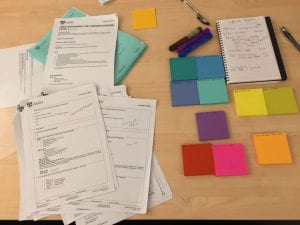A full week at Sydney Uni!
Highlights from the week 28 October – 1 November:
Research on vinyl cutter
One of the initiatives my supervisor was currently working on was to purchase a vinyl cutter for the Library. For the Learning Spaces area, this would be useful for creating signage decals. A proposal had been put forward to the Director to combine staff and student use for the vinyl cutter by purchasing it to be housed in the Library makerspace, Thinkspace, and therefore provide value to library users as well as the administrative staff. Five models had been included as potential recommendations in the proposal. I was tasked with doing some further research on these models and meeting with my supervisor and the manager for Thinkspace to present my findings. I was pleased to have my recommended cutter requested, with some of my arguments used to support the suggestion, and ordered.

Research on persona templates
The initial plan for the user experience (UX) research for the Conservatorium of Music (the Con) Library was to get information from students representing different courses, subject streams, years, and so forth and create personas to inform renovation plans. To that end, I was asked to look into potential persona templates to use in the project. Creating personas is frequently used in marketing and commercial UX projects. Many of the persona creation and template sites had a high amount of demographic and “buying habits” information that was not useful for our context. I found a simple, straightforward and easily customisable template at Xtensio. I created an example for our project on that platform.

Affinity mapping and themes analysis
Before we could create personas, we needed to process and analyse the data that we had collected. We did this by transferring the statements from the interviews onto post-it notes. The notes were colour-coded by course level and subject stream. When we had transcribed all of the statements, we transferred them to large sheets of paper on the wall in thematic groups, labelling the themes above the groups of notes. This created an affinity diagram.

Analysing the diagram led us to change our minds about the creation of personas. Themes did not seem to be grouped according to course level and content – no distinct personas really jumped out as relevant. Therefore, we decided to formulate a general wish-list of sorts by summarising the strongest themes from the diagram as thematic statements.
Curriculum collection project
Julie, a student placement from TAFE, and I were given a project to recommend short-term solutions for improving the safety, tidiness, and accessibility of a section of the stacks known as the Curriculum collection. This collection is used
primarily by Education students. The educational materials in this section present several challenges to standard shelving and there is a high level of disarray in the shelving area. Aside from looking untidy and presenting difficulties for patrons finding materials, there is also a health and safety concern with a risk of heavy materials falling on unwary users and staff. Julie and I were asked to identify challenges in the collection and potential quick, low-staff-resource solutions that could be implemented in the short term. We met with our supervisors and a staff member who had started work on this project but been pulled to a more urgent one and then set to work.
Challenges identified included:
- poorly designed bookends
- a wide variety of formats intershelved, including
- large runs of heavy soft-covered textbooks
- many multi-piece kits contained in hanging resource bags, but placed on regular shelving
- a wide variety of material sizes
- picture books and chapter books intershelved in long runs
The suggested solutions we are proposing include:
- exclusive use of large flat bookends (already in partial use)
- mid-shelf as well as end-of-shelf use of the large bookends (with 3 bookends per shelf in the picturebook sections)
- replacing kit bags with rigid, clear, polypropolene document boxes where dimensions allow
- placing kits larger than document box size, but below 9cm into pamphlet files boxes
- placing multiple copies of soft-cover books into pamphlet file boxes
To recommend quantities of these solution materials for purchase, we conducted an audit of the shelves. Due to the limited time available, we decided to audit sample areas, take an average of the needs identified in them, then apply that estimate to other shelve areas of similar composition. We identified four main compositional types and performed a sample audit:
- basic shelves – a combination of hard and soft-cover books (including textbooks), serials in pamphlet boxes, and some kits.
- language kit-heavy – kit-heavy sections in the foreign language section
- STEM kit-heavy – kit-heavy sections in Maths and Sciences sections
- Children’s literature – picture books and chapter books intershelved in large quantities
Next week we will complete our write-up and apply our estimates to a shelving map and present this to our supervisors. Hopefully this will lead to improvements in this area in the near future.
All in all – an interesting and productive week on placement!